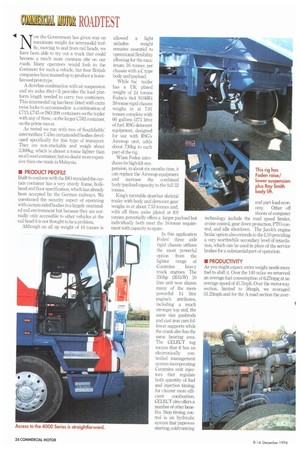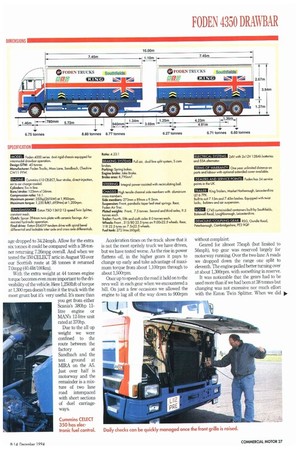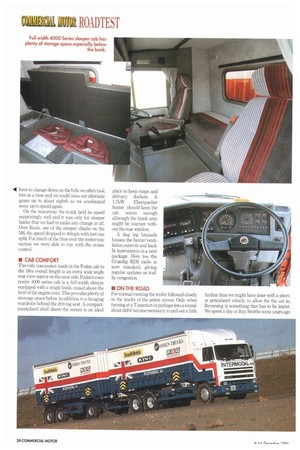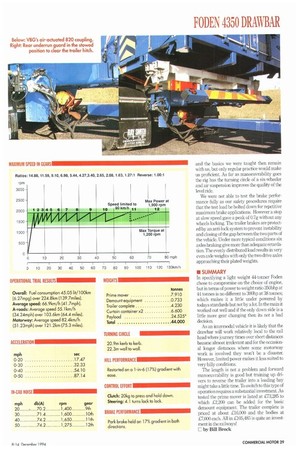\ ( Av the Government has given way on maximum weight
Page 28

Page 29

Page 30

Page 31

If you've noticed an error in this article please click here to report it so we can fix it.
for intermodal traffic, moving to and from rail heads, we have been able to try out a truck that could become a much more common site on our roads. Many operators would look to the Continent for such a vehicle, but four British companies have teamed up to produce a homebrewed prototype.
A drawbar combination with air suspension and six axles (6x4+3) provides the load platform length needed to carry two containers. This intermodal rig has been fitted with extra twist locks to accommodate a combination of C715, C745 or ISO 20ft containers on the trailer with any of these, opthe larger C782 container, on the prime moven As tested we ran with two of Southfields' intermediate 7.45m curtainsided bodies developed specifically for this type of transport. They are non-stackable and weigh about 3,300kg, which is almost a tonne lighter than an all-steel container, but no doubt more expensive than one made in Malaysia.
• PRODUCT PROFILE Built to conform with the ISO standard the curtain container has a very sturdy frame, bulkhead and floor specification, which has already been accepted by the German railways. We questioned the security aspect of operating with curtain sided bodies in a largely unattended rail environment but because they are normally only accessible to other vehicles at the rail head it is not thought to be a problem.
Although an all up weight of 44 tonnes is allowed a light unladen weight remains essential to operational flexibility allowing for the max imum 16 tonnes per chassis with a C type body and payload.
While the trailer has a UK plated weight of 24 tonnes Foden's 6x4 S106R4 26-tonne rigid chassis weighs in at 7.91 tonnes complete with 60 gallons (273 litre) of fuel. RSG demount equipment, designed for use with RSG's Airswop unit, adds about 730kg to each part of the rig.
When Foden introduces its high lift sus pension, in about six months time, it can replace the Airswop equipment and increase the combined body/payload capacity to the full 32 tonnes.
King's turntable drawbar skeletal trailer with body and demount gear
weighs in at about 7.53 tonnes and, with all three axles plated at 8.0 tonnes, potentially offers a larger payload but individually both meet the 16-tonne requirement with capacity to spare.
In this application Foden' three axle rigid chassis utilizes the most powerful option from the lighter range of Cummins heavy truck engines. The 350hp (261kW) 10 litre unit now shares many of the more powerful 14 litre engine's attributes, including a much stronger top end, the same size pushrods and cast iron cam follower supports while the crank also has the same bearing area. The CELECT tag means that it has an electronically controlled management system incorporating Cummins unit injectors that regulate both quantity of fuel and injection timing, for cleaner more efficient combustion. CELECT also offers a number of other benefits. Step timing control is an hydraulic system that improves starting, cold running and part load economy. Other off shoots of computer technology include the mad speed limiter, cruise control, gear down protection, PTO control, and idle shutdown. The Jacob's engine brake option also extends to the L10 providing a very worthwhile secondary level of retardation, which can be used in place of the service brakes for a substantial part of operation.
• PRODUCTIVITY As you might expect, extra weight needs more fuel to shift it. Over the 140 miles we returned an average fuel consumption of 6.27mpg at an average speed of 41.7mph. Over the motorway section, limited to 56mph, we averaged 51.23mph and for the A road section the aver age dropped to 34.24mph. Allow for the extra six tonnes it could be compared with a 38-tonner returning 7.26mpg overall. And when we tested the 350 CELECT artic in August '93 over our Scottish route at 38 tonnes it returned 7.0mpg (40.41it1100km).
With the extra weight at 44 tonnes engine torque becomes even more important to the driveability of the vehicle. Here 1,2501bft of torque at 1,300 rpm doesn't make it the truck with the most grunt but it's very useful. It's more than you get from either Scania's 380hp 11litre engine or MAN's 12-litre unit rated at 370hp.
Due to the all up weight we were confined to the route between the factory at Sandbach and the test ground at MIRA on the A5. Just over half is motorway and the remainder is a mixture of two lane road interspaced with short sections of duel carriageways. Acceleration times on the track show that it is not the most spritely truck we have driven, but we have tested worse. As the rise in power flattens off, in the higher gears it pays to change up early and take advantage of maximum torque from about 1,100rpm through to about 1,500rpm.
Once up to speed on the road it held on to the revs well in each gear when we encountered a hill. On just a few occasions we allowed the engine to lug all of the way down to 900rpm without complaint.
Geared for almost 75mph (but limited to 56mph), top gear was reserved largely for motorway running. Over the two lane A roads we dropped down the range one split to eleventh. The engine pulled better turning over at about 1,300rpm. with something in reserve.
It was noticeable that the gears had to be used more than if we had been at 38 tonnes but changing was not excessive nor much effort with the Eaton Twin Splitter. When we did have to change down on the hills we often took two at a time and we could miss out alternate gears up to about eighth as we accelerated away up to speed again.
On the motorway the truck held its speed surprisingly well and it was only for steeper banks that we had to make any change at all. Over Keele, one of the steeper climbs on the M6, the speed dropped to 40mph with just one split. For much of the time over the motorway section we were able to run with the cruise control.
• CAB COMFORT The only concession made in the Foden cab to the 18m overall length is an extra wide angle rear view mirror on the near side, Foden's composite 4000 series cab is a full-width sleeper equipped with a single bunk, raised above the level of the engine cowl. This provides plenty of stowage space below in addition to a hanging wardrobe behind the driving seat. A compartmentalized shelf above the screen is an ideal
place to keep maps and delivery dockets. A 1.7kW Eberspacher heater should keep the cab warm enough although the bunk area might be warmer without the rear window.
A dog leg binnacle houses the heater/ventilation controls and back lit instruments in a neat package. Here too the Grundig RDS radio is now standard, giving regular updates on traffic congestion.
• ON THE ROAD For normal running the trailer followed closely in the tracks of the prime mover. Only when turning at a T-junction or perhaps into a roundabout did it become necessary to pull out a little further than we might have done with a shorter articulated vehicle, to allow for the cut in. Reversing is something that has to be learnt. We spent a day at Ray Smiths some years ago and the basic:, we were taught then remain with us, but only regular practice would make us proficient. As far as manoeuvrability goes the rig has the turning circle of a six-wheeler and air suspension improves the quality of the level ride.
We were not able to test the brake performance fully as our safety procedures require that the test load be bolted down for repetitive maximum brake applications. However a stop at slow speed gave a peak of 0.7g without any wheels locking. The trailer brakes are protected by an anti-lock system to prevent instability and closing of the gap between the two parts of the vehicle. Under more typical conditions six axles braking give more than adequate retardation. The evenly distributed load results in very even axle weights with only the two drive axles approaching their plated weights
• SUMMARY In specifying a light weight 44-tonner Foden chose to compromise on the choice of engine, but in terms of power to weight ratio 350bhp at 44 tonnes is no different to 300hp at 38 tonnes; which makes it a little under powered by todays standards but not by a lot. In the main it worked out well and if the only down side is a little more gear changing then its not a bad decision.
As an intermodal vehicle it is likely that the drawbar will work relatively local to the rail head where journey times over short distances become almost irrelevant and for the occasional longer distances where some motorway work is involved they won't be a disaster. However, limited power makes it less suited to very hilly conditions.
The length is not a problem and forward manoeuvrability is good but training up drivers to reverse the trailer into a loading bay might take a little time. To switch to this type of operation requires a substantial investment. As tested the prime mover is listed at £73,285 to which £2,200 can be added for the basic demount equipment. The trailer complete is priced at about £16,000 and the bodies at £7,000 each. All in £105,485 is quite an investment in the railways!
E by Bill Brock
























































































